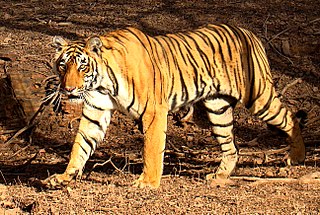
The tiger is the largest living cat species and a member of the genus Panthera. It is most recognisable for its dark vertical stripes on orange fur with a white underside. An apex predator, it primarily preys on ungulates, such as deer and wild boar. It is territorial and generally a solitary but social predator, requiring large contiguous areas of habitat to support its requirements for prey and rearing of its offspring. Tiger cubs stay with their mother for about two years and then become independent, leaving their mother's home range to establish their own.

The leopard is one of the five extant species in the genus Panthera, a member of the cat family, Felidae. It occurs in a wide range in sub-Saharan Africa, in some parts of Western and Central Asia, Southern Russia, and on the Indian subcontinent to Southeast and East Asia. It is listed as Vulnerable on the IUCN Red List because leopard populations are threatened by habitat loss and fragmentation, and are declining in large parts of the global range. The leopard is considered locally extinct in Hong Kong, Singapore, South Korea, Jordan, Morocco, Togo, the United Arab Emirates, Uzbekistan, Lebanon, Mauritania, Kuwait, Syria, Libya, Tunisia and most likely in North Korea, Gambia, Laos, Lesotho, Tajikistan, Vietnam and Israel. Contemporary records suggest that the leopard occurs in only 25% of its historical global range.
Panthera is a genus within the family Felidae that was named and described by Lorenz Oken in 1816 who placed all the spotted cats in this group. Reginald Innes Pocock revised the classification of this genus in 1916 as comprising the tiger, lion, jaguar, and leopard on the basis of common cranial features. Results of genetic analysis indicate that the snow leopard also belongs to the genus Panthera, a classification that was accepted by IUCN Red List assessors in 2008.

The Bengal tiger is a population of the Panthera tigris tigris subspecies. It ranks among the biggest wild cats alive today. It is considered to belong to the world's charismatic megafauna.

The Siberian tiger or Amur tiger is a population of the tiger subspecies Panthera tigris tigris native to the Russian Far East, Northeast China and possibly North Korea. It once ranged throughout the Korean Peninsula, but currently inhabits mainly the Sikhote-Alin mountain region in southwest Primorye Province in the Russian Far East. In 2005, there were 331–393 adult and subadult Siberian tigers in this region, with a breeding adult population of about 250 individuals. The population had been stable for more than a decade because of intensive conservation efforts, but partial surveys conducted after 2005 indicate that the Russian tiger population was declining. An initial census held in 2015 indicated that the Siberian tiger population had increased to 480–540 individuals in the Russian Far East, including 100 cubs. This was followed up by a more detailed census which revealed there was a total population of 562 wild Siberian tigers in Russia. As of 2014, about 35 individuals were estimated to range in the international border area between Russia and China.

The Indochinese tiger is a population of the Panthera tigris tigris subspecies that is native to Southeast Asia. This population occurs in Myanmar, Thailand, and Laos. In 2011, the population was thought to comprise 342 individuals, including 85 in Myanmar and 20 in Vietnam, with the largest population unit surviving in Thailand estimated at 189 to 252 individuals during 2009 to 2014.

The Caspian tiger was a Panthera tigris tigris population native to eastern Turkey, northern Iran, Mesopotamia, the Caucasus around the Caspian Sea, Central Asia to northern Afghanistan, and the Xinjiang region in western China. Until the Middle Ages, it was also present in Ukraine and southern Russia. It inhabited sparse forests and riverine corridors in this region until the 1970s. This population was regarded as a distinct subspecies and assessed as extinct in 2003.

Panthera tigris tigris, sometimes referred to as the mainland Asian tiger, is the native tiger subspecies of mainland Asia comprising the following tiger populations:

The South China tiger is a population of the Panthera tigris tigris subspecies that is native to southern China. The population mainly inhabited the Fujian, Guangdong, Hunan and Jiangxi provinces. It has been listed as Critically Endangered on the IUCN Red List since 1996 and is possibly extinct in the wild since no wild individual has been recorded since the late 1980s. In the late 1990s, continued survival was considered unlikely because of low prey density, widespread habitat degradation and fragmentation, and other human pressures. In the fur trade, it used to be called Amoy tiger.

The Javan tiger was a Panthera tigris sondaica population native to the Indonesian island of Java until the mid-1970s. It was hunted to extinction, and its natural habitat converted for agricultural land use and infrastructure. It was one of the three tiger populations in the Sunda Islands.

Sinanthropus is an archaic genus in the scientific classification system to which the early hominid fossils of Peking man, Lantian Man, Nanjing Man, and Yuanmou Man were once assigned. All of them have now been reclassified as Homo erectus, and the genus Sinanthropus is disused. Beginning in the year 1928 to the year 1937, 14 fragmented skulls belonging to the hominids were found in various locations in China. Peking and Chou K’ou-tien are two notable places with fossils found. It has been noted by researchers that it is likely that the found fragmented skulls were brought to the cave after being severed from the bodies they belonged to. This is very likely, because most of the found pieces are teeth and jaws. Some skulls are missing large parts which indicates separation before they were fossilized, not the loss of pieces due to fossilization process.

The Bali tiger was a Panthera tigris sondaica population on the Indonesian island of Bali which has been extinct since the 1950s.

The Malayan tiger is a tiger from a specific population of the Panthera tigris tigris subspecies that is native to Peninsular Malaysia. This population inhabits the southern and central parts of the Malay Peninsula and has been classified as critically endangered on the IUCN Red List since 2015. As of April 2014, the population was estimated at 80 to 120 mature individuals with a continuous declining trend.
Panthera palaeosinensis was an early Pleistocene species from northern China. It is often incorrectly referenced as the ancestor of the tiger, Panthera tigris, although it shares features with all living large cats. Recent studies place it close to the base of the genus Panthera.

Panthera tigris trinilensis, known as the Trinil tiger, is an extinct tiger subspecies dating from about 1.2 million years ago that was found at the locality of Trinil, Java, Indonesia. The fossil remains are now stored in the Dubois Collection of the National Museum of Natural History in Leiden, the Netherlands. Although these fossils have been found on Java, the Trinil tiger is probably not a direct ancestor of the Javan tiger. The Trinil tiger probably became extinct 50,000 years ago. The Bali tiger was also not closely related to the Trinil because of their time differences.

The Sunda Island tiger is a tiger subspecies native to the Sunda Islands in Indonesia. The name refers to the:

The giant tapir is an extinct species of tapir that lived in southern China, Vietnam and Laos, with reports suggesting it also lived in Taiwan, Java, and potentially on Borneo. The species has been recorded from Middle and Late Pleistocene. There is only weak evidence for a Holocene survival. Tapirus augustus was significantly larger than any living tapir, with an estimated weight of about 623 kilograms (1,373 lb). The species was also placed in its own genus of Megatapirus, however, it is now conventionally placed within Tapirus.

The Amur leopard is a leopard subspecies native to the Primorye region of southeastern Russia and northern China. It is listed as Critically Endangered on the IUCN Red List as in 2007, only 19–26 wild leopards were estimated to survive in southeastern Russia and northeastern China. It is considered one of the rarest cats on Earth.
Panthera tigris soloensis, known as the Ngandong tiger, is an extinct subspecies of the modern tiger species. It inhabited the Sundaland region of Indonesia during the Pleistocene epoch.

The Bornean tiger is possibly an extinct tiger population that may have lived on the island of Borneo in prehistoric times. A live Bornean tiger has not been conclusively recorded, but the indigenous Dayak people believe in its existence and report sightings on occasion.
















